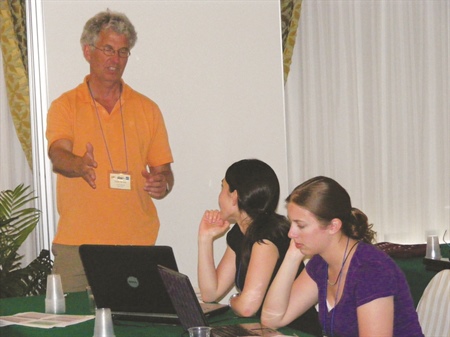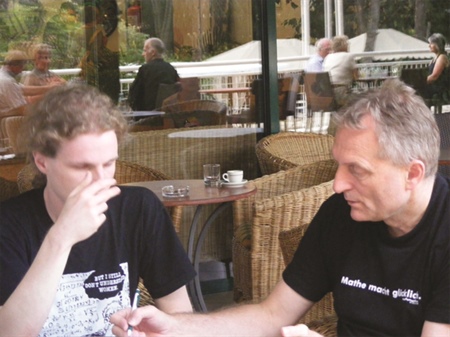Intense and Stimulating, First Golub Summer School Sets the Bar High
In June 2010, 52 graduate students from universities in 19 countries gathered in Selva di Fasano, Italy, for the first Gene Golub SIAM Summer School. Tucked away in the hills of southern Italy, the scenic Hotel Sierra Silvana was an ideal locale for the meeting. Founded by SIAM and supported in part by a bequest from Gene Golub, the two-week summer school offered graduate students in applied mathematics and computational science an opportunity to learn about current developments in numerical linear algebra from some of the world’s leading experts: Jim Demmel (University of California at Berkeley), Volker Mehrmann (Technische Universität Berlin), Charlie Van Loan (Cornell University), and Margaret Wright (Courant Institute, NYU).
The Organizers’ Perspective
The two-week school was the second in a series of International Summer Schools on Numerical Linear Algebra (ISSNLA) organized by the SIAM Activity Group on Linear Algebra; the first was held in 2008 in Castro Urdiales, Spain. The second ISSNLA was also the first Gene Golub SIAM Summer School, named for one of the leading figures in the matrix computation and scientific computing communities; we were deeply honored to be able to celebrate his memory with such an appropriate event.
A major positive effect of the summer school will be to create a strong sense of community in some of the next generation. — Margaret Wright
The SIAM Board’s generous allocation of funds from the Golub bequest partially covered students’ travel and local expenses and made it possible for the school to be a two-week event (the school in Castro Urdiales ran for only one week). A grant from the U.S. National Science Foundation, obtained by Daniel Szyld and Ilse Ipsen, covered a large part of the expenses for students from U.S. universities. The European Mathematical Society and several local institutions, such as the ICT department of CNR and INdAM–GNCS, also provided financial support.

The school was open to master’s and doctoral students from countries all over the world; more than 120 students applied for the 52 places. The selection process was possibly the hardest task of the Steering Committee, as the applicants all had outstanding qualifications. Seeing such a high-quality and vibrant emerging community was in itself a rewarding experience.
The students had to work hard, as the program was quite dense and intense. The school featured two courses each week: given by Charlie Van Loan and Jim Demmel the first week, and by Margaret Wright and Volker Mehrmann the second. Each 15-hour course consisted of ten hours of lectures plus five hours of supervised computing exercise sessions. The most recent student version of Matlab, donated by Cleve Moler and The Mathworks to all registered participants, was used to perform computational tasks. We are grateful to all the lecturers, whose seemingly endless energy and enthusiasm made each course a tour de force.
With some editing, the students’ solution of an open problem Charlie and I proposed should become a publication, one of the best outcomes one could hope for from such a short course. — Jim Demmel
The students were highly motivated and readily grasped the aim of the school, actively interacting with the lecturers on the program topics and on their own research subjects. People could be seen working in groups at any time of the day and evening, facing the (surprisingly deserted) swimming pool. We heard of groups successfully addressing open problems posed by the lecturers, activities that went far beyond any expectation from our side. It was in this stimulating atmosphere that the students spontaneously organized evening workshops during the second week; in presenting and sharing their research problems with their future colleagues, they were no doubt fostering future scientific collaborations.
The location, a largely dedicated hotel in a cozy village surrounded by century-old olive trees, certainly helped create and strengthen many friendships. The sea was out of sight and thus did not interfere with the main focus of the school, but all enjoyed the sea breeze and the particularly good weather throughout the stay. This being Italy, some leisure time was also mandatory: The nonscientific program included well-attended team games, a day at the beach, and visits to nearby caves and some of the region’s famous trulli. By farewell time, many new scientific collaborations and connections had been established. We hope that the school will be as unforgettable an experience for the students as it was for us.
— Nicola Mastronardi, IAC–CNR Bari, Filippo Notarnicola, IAC–CNR Bari, and Valeria Simoncini, Universitá di Bologna.
Students’ Perspective
The summer school program consisted of intense morning lectures followed by afternoon problem-solving sessions assisted by each of the lecturers. During the first week, Charlie Van Loan and Jim Demmel shared their expertise on tensor algebra and matrix communications: Van Loan’s course was an introduction to the use of tensors in multilinear algebra, and Demmel’s course discussed in detail the communication aspects of algorithms and the importance of effective management of data in linear algebra computations. In the second week’s courses, Margaret Wright presented numerical optimization strategies, offering insight on the connection between linear algebra and optimization, and Volker Mehrmann discussed perturbation theory and linearization techniques for the nonlinear eigenvalue problem.
The long-term value of the summer school is in the friendships formed between the students. — Charlie Van Loan
Each day, the lecturers assigned problems based on the material from the morning lectures, ranging from relatively simple experiments all the way to current open questions in the field. By the end of the first week, for example, Jim Demmel and Charlie Van Loan realized that they could formulate an open problem relating the communication-optimal algorithms presented by Demmel and the tensor operations presented by Van Loan. One student team solved it, writing down a tensor contraction algorithm with a proof of communication optimality.
The afternoon sessions were less structured, with students working in groups or having one-on-one time with the instructors. Generally, students took advantage of the sunny summer Italian afternoons to discuss the material around the swimming pool or in the stunning gardens surrounding the hotel. The interesting nature of the problems, the collaborative effort, and the beautiful locale led to the formation of strong academic bonds and increased the curiosity of the participants in the subjects.
Although the lectures and problem sessions could be quite intense, there was ample time for relaxation. The lengthy and delicious southern Italian meals and numerous coffee breaks gave students the opportunity to get to know each other on both a professional and a personal level. Further encouraging the bonding experience, the organizers had arranged for a competitive game night. Five teams competed in the events, which included a swimming race and an obstacle course run. The competition was judged by the lecturers, and the coveted prizes were cases of Belgian, German, Italian, and American beer.

The weekend in the middle of the summer school brought a much-needed break and afforded attendees the chance to further socialize and to explore the surrounding areas. A large contingent opted to spend an afternoon basking in the sun at the beach near the hotel, while others chose to explore the historic district of the nearby city of Bari. Other excursions that took place over the weekend were a visit to the Fasano zoo and a tour of the elaborate caves at the Grotte di Castellana.
Perhaps the most beneficial aspect of the summer school for many students was simply the opportunity to meet and interact with a large group of numerical analysts, all just beginning their mathematical careers. The discovery of so many people with similar research interests led to student-organized evening roundtable sessions, informal gatherings that allowed participants a few minutes to talk about their current research activities. These gatherings were so successful that a number of student talks were integrated into the agenda for the final day of the school.
The sharing of students’ research interests might become an even more integral part of the school’s program in future years. As suggested by Margaret Wright, a former student of Gene Golub, such student interaction is exactly what Gene Golub loved to see.
The first Gene Golub SIAM Summer School was a tremendous success. The lecturers took a great deal of time to get to know all participants and to design engaging talks and intellectually challenging problem sessions. They also agreed to give up some of their time to judge the competitive games. The dedication of both judges and administration was most appreciated. In particular, Nicola Mastronardi’s contributions cannot be overstated. His team and his family made sure that all participants felt welcome and comfortable visiting and studying in southern Italy. All in all, the summer school provided a great opportunity for young mathematicians to develop professional contacts and embark on lasting friendships, while gaining valuable knowledge about numerical linear algebra and paying a wonderful tribute to the legacy of Gene Golub.
More information on the school, including all lecture videos, is available online.
— Veronica Bustamante, Emory University, and Steven Hamilton, Emory University.
The idea of a summer school for graduate students from around the world is the perfect way to honor Gene’s memory. It is exactly the kind of activity that Gene loved to promote. — Charlie Van Loan
All in all very well organized and fully in Gene’s spirit. — Volker MehrmannI’m certain that Gene would have been delighted to see these lively representatives of the next generation. — Margaret Wright
Stay Up-to-Date with Email Alerts
Sign up for our monthly newsletter and emails about other topics of your choosing.



